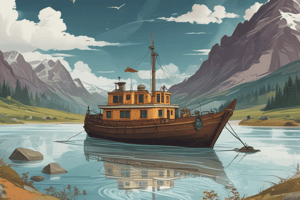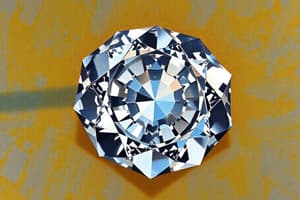Podcast
Questions and Answers
What is considered a clarity characteristic in gemstones?
What is considered a clarity characteristic in gemstones?
- The overall size of the gemstone
- Blemishes on the surface (correct)
- The carat weight of the stone
- Color variations within the stone
What type of loupe is recommended for examining gemstones to avoid distortion?
What type of loupe is recommended for examining gemstones to avoid distortion?
- Triplet loupe corrected for color and linear distortion (correct)
- Single element loupe with no corrections
- Plastic magnifying glass
- Standard glass loupe
Which type of characteristic is a crystal (Xtl) found within a diamond classified as?
Which type of characteristic is a crystal (Xtl) found within a diamond classified as?
- Surface feature
- Refraction artifact
- Blemish
- Inclusion (correct)
How is a blemish different from an inclusion when grading clarity?
How is a blemish different from an inclusion when grading clarity?
What illumination technique is most effective for making inclusions stand out clearly during examination?
What illumination technique is most effective for making inclusions stand out clearly during examination?
What characteristic of a bruise in a diamond is notable at 10x magnification?
What characteristic of a bruise in a diamond is notable at 10x magnification?
Which of the following statements about a knot in a diamond is true?
Which of the following statements about a knot in a diamond is true?
What change occurs to a patch of color due to the heat of the cutting process?
What change occurs to a patch of color due to the heat of the cutting process?
What is the main indication that a chip on a diamond might be present?
What is the main indication that a chip on a diamond might be present?
What is the purpose of internal laser drilling in diamonds?
What is the purpose of internal laser drilling in diamonds?
How can the presence of a fracture filling treatment be identified?
How can the presence of a fracture filling treatment be identified?
What is the definition of a cavity in the context of diamond inclusions?
What is the definition of a cavity in the context of diamond inclusions?
Where is a nick typically found on a diamond?
Where is a nick typically found on a diamond?
What is the appearance of a twinning wisp in a diamond?
What is the appearance of a twinning wisp in a diamond?
What distinguishes cleavage from a feather in diamond inclusions?
What distinguishes cleavage from a feather in diamond inclusions?
How does internal graining affect a diamond's clarity grade?
How does internal graining affect a diamond's clarity grade?
What can a grain center in a diamond appear like?
What can a grain center in a diamond appear like?
What characteristic does a bearded girdle exhibit?
What characteristic does a bearded girdle exhibit?
What typically causes the appearance of clouds in diamonds?
What typically causes the appearance of clouds in diamonds?
What kind of appearance does an etch channel have?
What kind of appearance does an etch channel have?
What is the visual effect of heavily bearded girdles on diamonds?
What is the visual effect of heavily bearded girdles on diamonds?
In terms of grading, what is the main issue with clouds in a diamond?
In terms of grading, what is the main issue with clouds in a diamond?
What common characteristic do feathers and cleavage share?
What common characteristic do feathers and cleavage share?
What is the appearance of an abrasion on a diamond's surface?
What is the appearance of an abrasion on a diamond's surface?
What causes a burn on a diamond's surface?
What causes a burn on a diamond's surface?
How does a pit form on a diamond's surface?
How does a pit form on a diamond's surface?
What defines an extra facet on a diamond?
What defines an extra facet on a diamond?
What is a polish mark in diamond grading?
What is a polish mark in diamond grading?
Which condition is characterized by a wavy or bumpy area on a diamond's surface?
Which condition is characterized by a wavy or bumpy area on a diamond's surface?
What indicates a rough girdle on a diamond?
What indicates a rough girdle on a diamond?
Which of the following is a characteristic resulting from laser manufacturing?
Which of the following is a characteristic resulting from laser manufacturing?
What is a dop burn in diamond polishing?
What is a dop burn in diamond polishing?
Identify the feature that appears as a thin, dull white line on a diamond's surface.
Identify the feature that appears as a thin, dull white line on a diamond's surface.
Flashcards
Bruise (Br)
Bruise (Br)
A tiny impact area with root-like feathers visible at 10x magnification, sometimes appearing cottony, and radiating into the diamond.
Knot (K)
Knot (K)
An included diamond crystal extending to the surface after shaping, often looking like a slightly raised area on a facet or group of facets. They are oriented differently from the host diamond.
Patch Color (Patch)
Patch Color (Patch)
A naturally occurring colored stain on a diamond, originally green but sometimes turning brown due to heat from cutting. Can be either a blemish or inclusion depending on its depth.
Chip (Ch)
Chip (Ch)
Signup and view all the flashcards
Cavity (Cav)
Cavity (Cav)
Signup and view all the flashcards
Indented Natural (IN)
Indented Natural (IN)
Signup and view all the flashcards
Laser Drill-Hole (LDH)
Laser Drill-Hole (LDH)
Signup and view all the flashcards
Nick (Nck)
Nick (Nck)
Signup and view all the flashcards
Clarity Characteristics
Clarity Characteristics
Signup and view all the flashcards
Inclusions
Inclusions
Signup and view all the flashcards
Blemishes
Blemishes
Signup and view all the flashcards
Gemstone Clarity Grading
Gemstone Clarity Grading
Signup and view all the flashcards
Internal Inclusions (e.g., crystal)
Internal Inclusions (e.g., crystal)
Signup and view all the flashcards
Abrasion (Abr)
Abrasion (Abr)
Signup and view all the flashcards
Scratch (Scr)
Scratch (Scr)
Signup and view all the flashcards
Extra Facet (EF)
Extra Facet (EF)
Signup and view all the flashcards
Lizard Skin (LS)
Lizard Skin (LS)
Signup and view all the flashcards
Polish Lines (PL)
Polish Lines (PL)
Signup and view all the flashcards
Burn (Brn)
Burn (Brn)
Signup and view all the flashcards
Dop Burn
Dop Burn
Signup and view all the flashcards
Rough Girdle (RG)
Rough Girdle (RG)
Signup and view all the flashcards
Pit (Pit)
Pit (Pit)
Signup and view all the flashcards
Laser Manufacturing Remnant (LMR)
Laser Manufacturing Remnant (LMR)
Signup and view all the flashcards
Needle (Ndl)
Needle (Ndl)
Signup and view all the flashcards
Pinpoint (Pp)
Pinpoint (Pp)
Signup and view all the flashcards
Cloud (Cld)
Cloud (Cld)
Signup and view all the flashcards
Twinning Wisp (TW)
Twinning Wisp (TW)
Signup and view all the flashcards
Internal Graining (IG)
Internal Graining (IG)
Signup and view all the flashcards
Grain Center (GC)
Grain Center (GC)
Signup and view all the flashcards
Feather (Ftr)
Feather (Ftr)
Signup and view all the flashcards
Cleavage
Cleavage
Signup and view all the flashcards
Etch Channel (EC)
Etch Channel (EC)
Signup and view all the flashcards
Bearded Girdle (BG)
Bearded Girdle (BG)
Signup and view all the flashcards
Study Notes
Clarity Grading
- Clarity grading is a key aspect of GIA's grading system.
- Clarity characteristics are often called flaws or imperfections.
- Two types:
- Inclusions: features inside a gemstone, or extending from the surface.
- Blemishes: surface-confined features.
Examining Stones
- Examine with a jeweler's loupe (10x) or binocular microscope.
- Use a triplet loupe (color and linear distortion corrected)
- Chromatic aberration: rainbow effect around the viewing field.
- Spherical aberration: straight lines appear to bend at edges.
- Achromatic and aplanatic lenses correct these distortions.
- Darkfield illumination shows inclusions.
- Brightfield illumination shows them as black objects.
- Depth of field: area in focus; smaller with increased magnification.
- Prism images: multiple images of a characteristic due to diamond's refraction.
- Light source angle distinguishes between surface and internal characteristics.
Types of Clarity Characteristics
-
Internal Inclusions: mineral crystals (over 24 types identified).
- Needle: thin, rod-like crystal (white, bright, or dark).
- Pinpoint: tiny, dot-like crystal (mostly white, sometimes dark).
- Cloud: tightly grouped pinpoints (may be misty, gray, or dense).
- Twinning wisp: radiating pinpoints, clouds, or crystals in a twinning plane. Looks ribbon-like.
- Internal graining: irregular crystal growth (lines, angles, streak-like, colored or transparent).
- Grain center: small, focused area of growth distortion, white or dark.
-
Surface-Reaching Inclusions:
- Feather: general term for any break.
- Etch channel: angular opening in the surface, often with striations perpendicular to length.
- Bruise: area of impact with tiny feathers.
- Knot: a slightly raised included crystal extending to the surface.
- Patch of color: natural radiation stains (originally green, can turn brown).
- Chip: shallow opening.
- Cavity: opening from a feather break or crystal ejection.
- Indented natural: a portion of the original surface.
- Laser drill-hole: tunnel created by a laser beam.
- Internal laser drilling: expands or creates a feather around a dark inclusion.
Blemishes
- Rough girdle: irregular, pitted, or granular surface.
- Pit: small white dot.
- Laser manufacturing remnant (LMR): markings during laser manufacturing creating internal or surface fractures.
- Natural: part of the rough diamond's original surface (skin).
- Surface graining (SG): visible crystal structure lines on a facet.
- Nick: a small notch on a facet.
- Abrasion: scratch marks.
- Scratch: thin line.
- Extra facet: an unplanned facet.
- Polish mark: bumpy/wavy surface area.
- Lizard skin: wavy or bumpy area on surface
- Burn(Brn): hazy surface from excessive heat from polishing
Other Features
- Inscriptions: text, numbers, or logos (surface only).
- Surface grooves for invisible mounting.
Studying That Suits You
Use AI to generate personalized quizzes and flashcards to suit your learning preferences.




